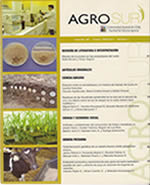Incidence and distribution of pesticide residues in leaf vegetables in the green belt of Cordoba
Main Article Content
Abstract
The objective of this study was to determine the presence of organophosphate and organochloride pesticides, and pyrethroid substances in the most consumed leaf vegetables in Cordoba, Argentina: Swiss chard (Beta vulgaris L. var. cicla L.), lettuce (Lactuca sativa L.), and spinach (Spinacia oleracea L.). The study covered the 2010-2013 period, and the geographic area included five vegetable-growing zones that make up the urban and periurban agriculture of Cordoba. The type of irrigation and the zones exceeding the maximum residue limits were considered. The “QuEChERS” Multiresidue technique was used to extract the pesticide residues from the plant tissue.
Residues were detected in 70 out of 311 analyzed samples. Pesticides were identified as endosulfan, deltamethrin, cypermethrin, bifenthrin, dimethoate, chlorpyrifos, chlorothalonil, malathion, and methamidophos. A total 22.5% samples were over the detection limit, while 10.92% exceeded the maximum residue limit. The Chi-squared test generated no positive associations between the presence of pesticides and a particular zone (Chi: 3.07; p= 0.5467). Among the vegetables, Swiss chard showed the highest amount of contaminants, although this difference was not significant (Chi: 2.81; p= 0.2454). Positive cases decreased in all the vegetables over the study period. Swiss chard decreased from 34.21% to 15.38%, lettuce from 30.34 to 23.53%; spinach started off with 17.86% and no positives were found in 2012 or 2013.

